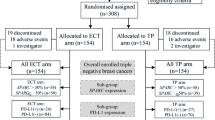Summary
Anthracycline-Taxane chemotherapy is widely used in neoadjuvant treatment for breast cancers. However, there is limited data reported in patients with triple negative breast cancer (TNBC). Here, we evaluated the pathologic responses and survival of neoadjuvant epirubicin and taxanes chemotherapy in patients with locally advanced TNBC to provide some useful information for clinical practice. A total of 43 patients with locally advanced TNBC were enrolled in this study. Patients were administered with epirubicin 75 mg/m2 plus paclitaxel 175 mg/m2 or docetaxel 75 mg/m2 every 3 weeks for at least 2 cycles. The primary endpoint was pathologic complete response (pCR), which was defined as no residual invasive cancer, or only carcinoma in situ in both the excised breast and axillary lymph node, while relapse-free survival (RFS) and overall survival (OS) were secondary endpoints. Thirty-nine (90.7%) patients were at clinical stages IIB-IIIC. Thirty-seven (86%) completed 4-6 cycles of preoperative chemotherapy, and objective response rate (ORR) was 81.4% (35/43). Forty-two patients underwent radical surgery subsequently. The pCR rate was 14.3% (6/42). The most common adverse events in neoadjuvant chemotherapy were nausea/vomiting (88.4%, 38/43) and neutropenia (88.4%). After a median follow-up period of 34.0 months, 3-year RFS and OS rate was 53.6% and 80.1%, respectively. All events of recurrence and death occurred in non-pCR patients, in whom the 3-year RFS and OS rates were 44.3% and 76.6%, respectively. This study suggest that neoadjuvant chemotherapy with epirubicin plus taxanes has a relatively low pCR rate and high early recurrence risk in locally advanced TNBC, which indicates the necessity for more efficacious treatment. Further study is needed to validate these results.
Similar content being viewed by others
References
Jemal A, Bray F, Center MM, et al. Global cancer statistics. CA Cancer J Clin, 2011,61(2):69–90
Siegel R, Naishadham D, Jemal A. Cancer statistics, 2012. CA Cancer J Clin, 2012,62(1):10–29
Bauer KR, Brown M, Cress RD, et al. Descriptive analysis of estrogen receptor (er)-negative, progesterone receptor (pr)-negative, and her2-negative invasive breast cancer, the so-called triple-negative phenotype: A population-based study from the California cancer registry. Cancer, 2007,109(9):1721–1728
Foulkes WD, Smith IE, Reis-Filho JS. Triple-negative breast cancer. N Engl J Med, 2010,363(20):1938–1948
Shimizu C, Ando M, Kouno T, et al. Current trends and controversies over pre-operative chemotherapy for women with operable breast cancer. Jpn J Clin Oncol, 2007,37(1):1–8
Kaufmann M, von Minckwitz G, Smith R, et al. International expert panel on the use of primary (preoperative) systemic treatment of operable breast cancer: Review and recommendations. J Clin Oncol, 2003,21(13):2600–2608
Keam B, Im S-A, Kim H-J, et al. Prognostic impact of clinicopathologic parameters in stage ii/iii breast cancer treated with neoadjuvant docetaxel and doxorubicin chemotherapy: Paradoxical features of the triple negative breast cancer. BMC Cancer, 2007,7(1):203
Wu J, Li S, Jia W, et al. Response and prognosis of taxanes and anthracyclines neoadjuvant chemotherapy in patients with triple-negative breast cancer. J Canc Res Clin Oncol, 2011,137(10):1505–1510
Carey L, Dees E, Sawyer L, et al. The triple negative paradox: Primary tumor chemosensitivity of breast cancer subtypes. Clin Cancer Res, 2007,13(8):2329–2334
Masuda H, Masuda N, Kodama Y, et al. Predictive factors for the effectiveness of neoadjuvant chemotherapy and prognosis in triple-negative breast cancer patients. Cancer Chemoth Pharm, 2011,67(4):911–917
Liedtke C, Mazouni C, Hess KR, et al. Response to neoadjuvant therapy and long-term survival in patients with triple-negative breast cancer. J Clin Oncol, 2008,26(8):1275–1281
Greene F, Page D, Fleming I, et al. AJCC cancer staging manual. 2002
Cleator S, Heller W, Coombes RC. Triple-negative breast cancer: Therapeutic options. Lancet Oncol, 2007,8(3):235–244
Nahleh Z. Neoadjuvant chemotherapy for “triple negative” breast cancer: A review of current practice and future outlook. Med Oncol, 2009,27(2):531–539
Metzger-Filho O, Tutt A, de Azambuja E, et al. Dissecting the heterogeneity of triple-negative breast cancer. J Clin Oncol, 2012,30(15):1879–1887
Lehmann BD, Bauer JA, Chen X, et al. Identification of human triple-negative breast cancer subtypes and preclinical models for selection of targeted therapies. J Clin Invest, 2011,121(7):2750–2767
Silver DP, Richardson AL, Eklund AC, et al. Efficacy of neoadjuvant cisplatin in triple-negative breast cancer. J Clin Oncol, 2010,28(7):1145–1153
Sirohi B, Arnedos M, Popat S, et al. Platinum-based chemotherapy in triple-negative breast cancer. Ann Oncol, 2008,19(11):1847–1852
Chang HR, Glaspy J, Allison MA, et al. Differential response of triple-negative breast cancer to a docetaxel and carboplatin-based neoadjuvant treatment. Cancer, 2010,116(18):4227–4237
Frasci G, Comella P, Rinaldo M, et al. Preoperative weekly cisplatin-epirubicin-paclitaxel with g-csf support in triple-negative large operable breast cancer. Ann Oncol, 2009,20(7):1185–1192
Sikov WM, Dizon DS, Strenger R, et al. Frequent pathologic complete responses in aggressive stages ii to iii breast cancers with every-4-week carboplatin and weekly paclitaxel with or without trastuzumab: A brown university oncology group study. J Clin Oncol, 2009,27(28):4693–4700
Dent R, Trudeau M, Pritchard KI, et al. Triple-negative breast cancer: Clinical features and patterns of recurrence. Clin Cancer Res, 2007,13(15):4429–4434
Kennecke H, Yerushalmi R, Woods R, Cheang MC, Voduc D, Speers CH, Nielsen TO, Gelmon K: Metastatic behavior of breast cancer subtypes. J Clin Oncol, 2010,28(20):3271–3277
Author information
Authors and Affiliations
Corresponding author
Rights and permissions
About this article
Cite this article
Yin, Y., Zhang, P., Xu, Bh. et al. Unfavorable pathological complete response rate of neoadjuvant chemotherapy epirubicin plus taxanes for locally advanced triple-negative breast cancer. J. Huazhong Univ. Sci. Technol. [Med. Sci.] 33, 262–265 (2013). https://doi.org/10.1007/s11596-013-1108-9
Received:
Published:
Issue Date:
DOI: https://doi.org/10.1007/s11596-013-1108-9




